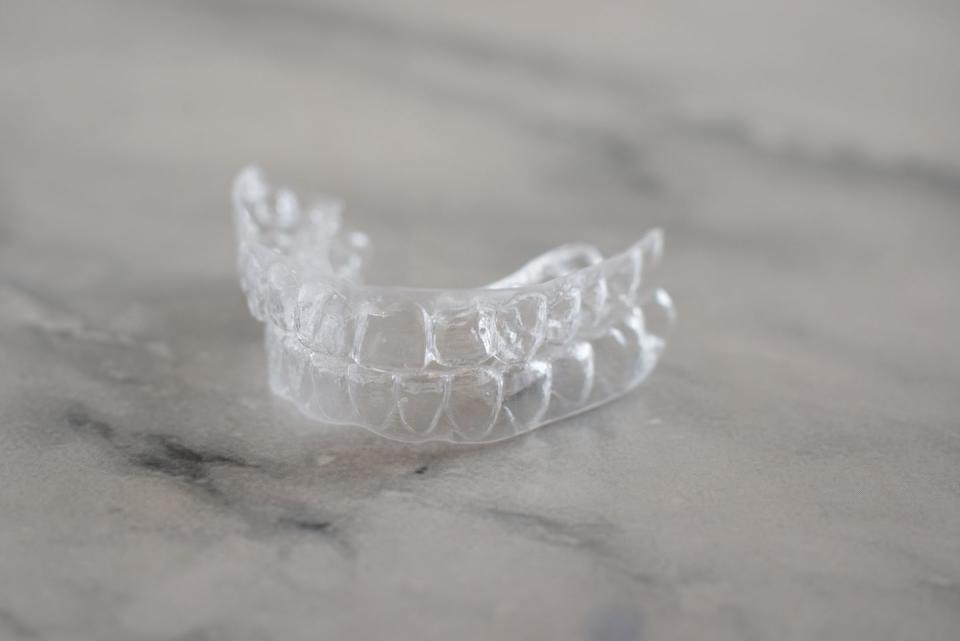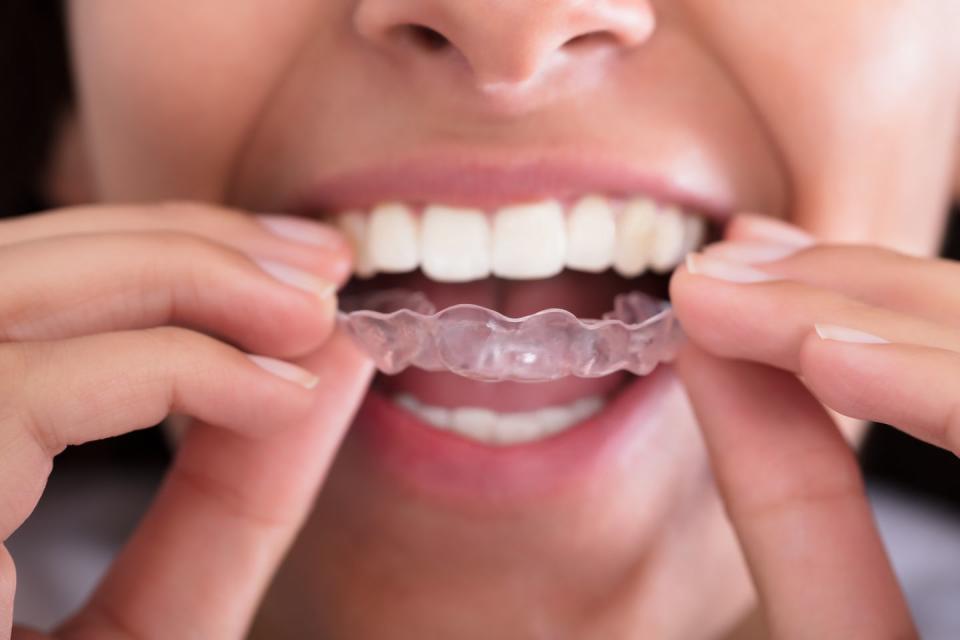Direct-to-Consumer Dental Aligners Are on the Rise. But Do They Work?

Straightening your teeth used to require dozens of visits to an orthodontist to adjust a mouthful of shiny metal hardware. Then, in the 1990s, Invisalign came out with a less obtrusive option: using a series of clear aligner trays, still overseen by an orthodontist or a dentist in his or her office. But in October 2017, 40 of Invisalign’s patents expired, opening the field to competitors. New companies have since flooded the market, offering versions that promise to do the job for less money, without time-consuming office visits.
But industry groups have raised questions about whether these direct-to-consumer
aligners can do more harm than good. The controversy intensified this year when the New York Times reported that customers who had bad experiences with the leading at-home aligner company, SmileDirectClub, were asked to sign nondisclosure agreements—prohibiting them from posting bad reviews, speaking with reporters, or even saying anything negative on social media—before the company would refund their money. Here’s the straight talk about these controversial smile straighteners.

A Money-Saving Choice
Companies like SmileDirectClub and Candid sell see-through aligners directly to consumers for about 60% less than Invisalign or traditional braces, which can range from $5,000 to $8,000. To customize the aligners, you either use a kit to make an impression of your teeth at home or visit one of more than 300 SmileDirect SmileShops across the U.S. (some are stand-alone, while others are located inside other chains, including CVS and Walgreens drugstores). In-shop Smile Guides—who are not dentists or orthodontists, though some have experience as dental assistants—take digital 3D images of your mouth and send them to an orthodontist or a dentist assigned to your case, says Jeffrey Sulitzer, D.M.D., SmileDirectClub’s chief clinical officer. Those professionals prescribe the plan of care remotely, but never actually see you in person.
While hundreds of thousands of people have tried direct-to-consumer aligners, the American Association of Orthodontists (AAO) recently issued a strongly worded consumer alert stating that if orthodontic treatment was not done correctly, this could lead to “potentially irreversible and expensive damage such as tooth and gum loss, changed bites, and other issues.” The AAO went on to question why anyone would consider getting a transformative medical treatment without in-person supervision from a medical professional.

At-Home Orthodontia: The Downsides
One of the biggest concerns about this kind of tele-dentistry involves the gums and structures that support the teeth, says Sean Murphy, vice president of advocacy at the AAO. “Two-thirds of what happens in the mouth is below the gums, beyond the visible portion of the teeth,” he says. Using an aligner can exacerbate or incite issues such as gum recession, says Murphy, and if you’re not seeing an orthodontist regularly in person for adjustments, problems can go unchecked, potentially requiring more treatment later at additional cost. In some cases, attempting to move teeth while there’s active gum disease can make gum disease worse, says William E. Graves, D.M.D., an Amarillo, TX, oral surgeon who points out that about 42% of Americans didn’t see a dentist last year.
Even if there are no gum issues, there’s the question of how effective this type of treatment is for most people. With traditional braces or aligners, “your orthodontist or dentist is constantly evaluating how the treatment is progressing and adjusting accordingly,” says Matt Nejad, D.D.S., a cosmetic dentist in Beverly Hills. That may include modifying space between teeth, adding or removing attachments, or even taking new impressions to create a whole new set of aligners to get teeth back on track. The proportion of patients who have the kinds of dental issues that can be addressed adequately with long-distance care—and not require the many refinements that are typical when treating teeth effectively with aligners—is small, Nejad says. “We’re talking about people who maybe have one tooth that needs to be moved. It just doesn’t work for even average to complex cases.”
Nejad also questions the at-home impression-taking process. “Taking impressions is truly an art. Even experienced dentists don’t always take amazing ones, but we can do it again if necessary,” he says. And one of the most difficult things, says Nejad, is the fine-tuning of the patient’s bite, done near the end of the process. This step, he says, is completely lacking in some of the direct-to-consumer options, and skipping it “can create a lot of long-term problems.”
All this adds up to the possibility that you may not get the smile you hoped for, and you could wind up with other issues. Yet SmileDirectClub will only grant full refunds within the first 30 days—well before customers can tell whether they will see any long-term results, positive or negative. (The company has recently updated its policy to allow prorated refunds on any unused aligners.)

The Future of Tele-Dentistry
The makers of direct-to-consumer aligners say their product is being mischaracterized. SmileDirectClub’s Sulitzer argues that charges of “do-it-yourself dentistry” are unfounded, as the process is prescribed, directed, and managed by dental professionals from beginning to end. “The only difference is that visits are done virtually, through our platform,” he says. “All the standards of care are the same as in these providers’ private practices. The status checks are done at regular intervals, from once a month to every 90 days.” The company, which dominates the category, is opening new locations every month, working toward making sure every potential patient can be seen in person by a SmileShop technician if that’s what he or she wants. Also, SmileDirectClub announced in January that it will soon sell its services to dentists and orthodontists who can offer the aligners through their offices, but that will presumably bump up the overall cost of the treatment.
As for the idea that in-person appointments are the holy grail, Sulitzer points to independent studies touting the efficacy of using a telehealth platform to diagnose cavities (because direct-to-consumer aligners are so new, no long-term studies have assessed their success). “We find that organized dentistry is shooting down something that’s new and innovative,” says Sulitzer. “We’ve done our best to work with the associations to educate them and give them an understanding of what we’re doing.”
If you've considered the risks and rewards and want to give direct-to-consumer aligners a try, follow these expert guidelines:
• Have at least one visit with an independent ortho: The only way to know whether your bite is a simple enough case to fix adequately with at-home aligners is to have an expert take a look, says Graves. People with one or two teeth to shift would be better candidates than those with more complex issues such as an overbite or an underbite, he adds.
• Get to the dentist: Before you sign up for any type of braces or aligners, make sure your mouth is free of cavities and gum disease and healthy enough to endure the treatment, says Graves, and schedule regular dental checkups while you’re using the aligners. “Skipping this step and going straight into that type of teeth straightening can do more harm to your mouth than good,” adds Graves.
• Think about your style: Because aligners get put in and taken out (unlike traditional metal braces), you need a great deal of personal commitment to be a good candidate for the treatment—especially the direct-to-consumer versions, says Graves. “They require a lot of discipline. If you don’t follow the instructions completely, you will be wasting your time and money.”
This article originally appeared in the May 2020 issue of Prevention.
Support from readers like you helps us do our best work. Go here to subscribe to Prevention and get 12 FREE gifts. And sign up for our FREE newsletter here for daily health, nutrition, and fitness advice.
You Might Also Like

